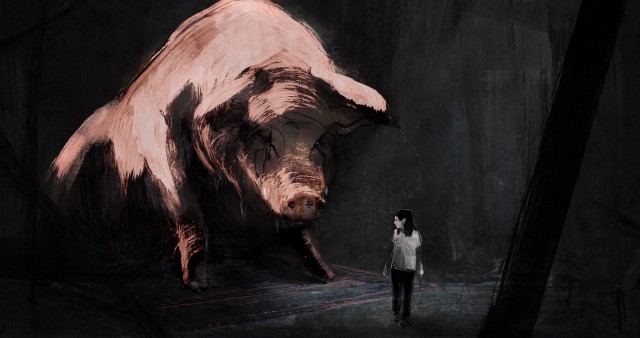During class, Alma and her classmates receive a visit from a Holocaust survivor. Set in a contemporary time frame, the aged man shares his experiences, including a somewhat whimsical, but also sincere, anecdote of how a pig saved his life. The kids are being kids—whispering to each other and making jokes behind the teacher’s back—but when one student is expelled from class the tone of the presentation changes. Feelings of gratitude fade into articulations of revenge as the tone of the survivor’s testimony shifts. Alma, a sensitive girl in the class, is thrown into a confused fantasy by the violence of his words, where, in a liminal dream state, she and her classmates try to reconcile the generational trauma they are inheriting with a vision of how to move forward. With Letter to a Pig, writer/director Tal Kantor captures how remembrance risks turning into destiny as traumas are passed down to future generations via collective memory, and what it might take to break the cycle.
“Can we talk about past traumas without transmitting them to future generations?”
It is a heavy, ambitious subject for a short film, and is based on a formative experience from Kantor’s youth. Similarly to Alma, Kantor was visited by a Holocaust survivor as a schoolgirl, and the resulting dream she had was seared into her mind. “Both the survival story and the dream left such a powerful mark that they evolved a decade later into a growing urge to create this film”, she shares. Exploring this as an adult, utilizing the tools afforded her by her talent and her art, has allowed her to take into account broad social questions of how the subconscious carrying of past traumas affects younger generations. Seen from the experience of Alma, this perspective empowers Kantor to bring in the authenticity of her own experience and critique the premise of a “never forget” ideology. “Can we talk about past traumas without transmitting them to future generations?”, she questions.
Holocaust stories have been depicted in many mediums many times, and while every single one is frightening, Letter to a Pig stands out because of its particular focus—instead of centering on events from the period, it turns its lens towards the new generation hearing about it, becoming about the process in which these wounds are remembered and kept fresh. Remembering is a double-edged sword, it binds a people together and honors one’s elders, but with an event as enormously evil and traumatic as the Holocaust, it also perpetuates darker emotions. Kantor’s focus on the transmission of this remembering is not made with activist zeal—it is poignant and nuanced to the ramifications thereof—but it potently identifies “the social and personal implications” of participating in a societal process that can be so easily bent towards hate. Memory is the starting point, and the medium of the film is vital in exploring this theme as the animation and Kantor’s specific style become a striking storytelling tool.

“The technique involves a fusion of 2D traditional hand-drawn and paint animation on paper, blended with video segments” – Kantor describing her production methods.
Animation is unusually effective at fantasy, but Kantor’s trademark mix of 2D animation and live action, seen in her prior work, In Other Words, is especially well-suited to the depiction of Alma’s experience between memory, life, and dreams. In an impressionistic manner, emotion is transmitted through the images in concert with Alma’s reception of the story, communicating her confusion and fear within a maelstrom of pain and hatred. The pig becomes an important symbol, as the only character in color, and the vessel of Alma’s emotional process, as she starts to see that life is not black and white, but full of nuance.
It is hard to remember a recent film that tackles such a large, abstract, yet important theme as Letter to a Pig does, and it does so in a sophisticated way, by capturing how memory, reality, and the subconscious intertwine and influence each other. And yet, the film is emotionally and intellectually legible too, as its honest and raw look at that charged topic is what makes the film so captivating and powerful. It is not only a great short, but an important one too—a film we expect to be referenced and returned to in the coming years.
Letter to a Pig earned a spot on the shortlist for the Animated Short Film category at the Oscars and thus is currently on an FYC campaign. This is on the back of a celebrated festival run, with selections including SFFILM, Guadalajara, and awards at Animafest Zagreb and Ottawa, to only name a few. We are pleased to present its online premiere and believe it will be a top contender during these next months of Award Season.

 Céline Roustan
Céline Roustan